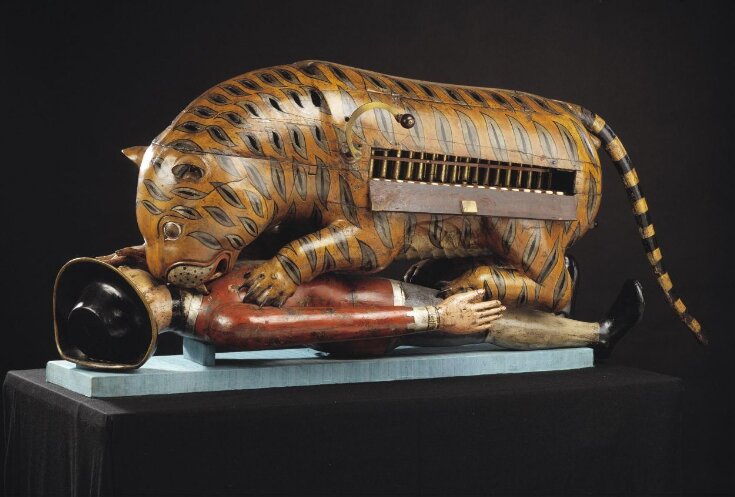Krispin Joseph PX
Addressing the question of the past stories and events around things is an exciting and essential subject in the art world. This question belongs to the stories and lives of our past generations. Some objects are available here, and we need to understand their social life and history.
The biography of a thing reveals the biography of whom they used in the past. If we look at the craftsmanship of the old time and the designing method of creative people of past societies, we get enough theories from objects. Objects are influential in telling the story and making precise visual arguments about past life: how manipulative and creative people lived here and there.
There are many specialities to study in object narration: engagements and activities in connection with materials, growth and communication through tools, craftsmanship and social mechanism, and many other elements of past societies that can acquire from the study of objects. Time and space are significant when we inquire about objects and materials. Objects are also known as artefacts in some way. If we call it so, Johannes Fabian clarifies artefacts: ‘artefacts are things that belong to culture rather than nature (2004); things connect to cultural settings and the life of the peoples. If we look at objects that way, we get some insight from past society’s cultures, what they thought and how they worked individually and collectively.
First of all, these things\artefacts\objects are the ‘other’ for everyone. These objects are not directly or indirectly connected with today’s life or culture; they treat as museum objects. However, we get some ideas about how culture evolved and developed, how we think about things and how culture developed in different places. Fabian believes in the ‘other’ in a Western tone. Other scholars like Chris Gosden and Yvonne Marshall think differently about objects. How we can read an object’s biography is the method they use. ‘The fame of the objects and the renown of people are mutually created (Chris Gosden, Yvonne Marshall 1999). Another critical argument comes through the Social life of things: ‘Commodities, like persons, have social lives (Appadurai 1988). These methods are equally reasonable in object study, and these arguments do not stand alone. Other scholars and their opinions view the objects/materials/things studied — finally, the question of the value of objects. According to Appadurai, ‘Economic exchange creates value. Worth is embodied in exchanged commodities (1998, 3).
Tippoo’s Tiger
Tippoo’s Tiger is one of the fascinating objects in the chosen list. This object’s content can be accessed by observing the design and form of a Tiger attacking a man. Furthermore, that design is to make a helpful system of musical instruments- a semi-automated mechanical organ. The important thing, these objects depict a tiger killing a European man. The object creates between ca. 1793–1797 in Mysore, Karnataka. Painted wood with metal fixtures and ivory is the material element of these objects — objects created for Tipu Sultan, King and ruler of Mysore in South India. The length of Tippoo’s Tiger is 178cm, the height is 71cm, and the Width is 61cm. Tiger’s body was all designed in the format of a musical instrument, an organ inside that wild animal.
The Connection between Tipu Sultan and Tiger has been a widely recognised myth for the last century. Tipu, known as Mysore Tiger, frequently uses the Tiger motif to illustrate his connection with the natural jungle king. These objects were discovered in the music room of Tipu Sultan’s palace and shipped to London with many other things; they were exhibited in the East India House and then transferred to the South Kensington Museum.
Tipu Sultan considered himself a fighter for his homeland against the British invaders. The Tiger motif helped him to express his power and wildness as King. That is the main point of getting it from these objects. The British army defeated the Mysore Tiger in 1799, and they looted many items from Tipu’s palace, including these Tiger objects.
The main attraction of these objects is, of course, the Tiger element. A British soldier lies down, and Tiger savages him with the military uniform. The Tiger uses the motif in many items like swords and guns as ornamentation. Tipu Sultan is one of India’s most essential kings to fight the British army without dread. He never surrendered like many other Indian Kings. He made his courageous move like a Tiger against the British army. Tipu Sultan used the Tiger motif to express himself to the people of Mysore as a powerful ruler. When the British army tried to attack Mysore, he used the same motif to describe his attitude toward them.
What social life do these objects present to us after a long time? If we look at the biographical perspective on these objects, we can observe that Tipu Sultan used these objects as a musical instruments daily. Otherwise, he treats these things only as a showcasing piece, representing his rigorous attitude towards the British. Now we look at and observe these objects in a certain way to understand the meaning of the objects. A fundamental point is the value of this object, which is the judgement made by us because of the person who uses this object.
Appadurai’s and Chris Gosden- Yvonne Marshall’s argument makes a clear view of the historical stories about the object’s social life. These objects indicate the biography of the King, his time and how craftsmanship addresses the royal need. The value of the thing is related to the value of the subject.
A fundamental matter belongs to the craftsmanship of the production of the object for Tipu Sultan, now called Tippoo’s Tiger. No evidence is available about the creator of this object; only we know Tipu Sultan owns this object. The owner creates the value of this object. The thing is valuable because the owner is a King. Here, we meet the reciprocal relation between object and subject. We do not know what the exchange value of these objects is. However, we do not need anyone’s statement to address this object as valuable and essential cultural material. That belongs to Tipu Sultan, the King and the rigorous man from South India who opposed British invaders frequently.
‘There is a mutual process of value creation between people and things, according to Chris Gosden and Yvonne Marshall in their essay on The Cultural Biography of Objects (1999, 169–178). This argument contradicts the connection between the power and indigenous attitude Tipu Sultan kept with the Kingship and how he managed the regime against the British army. He fought three wars against the British army. Only after the third war did he and his place surrender to the British. When the British defeated Tipu Sultan, things take from the palace, including these ‘Tiger’ instruments. The British army generals and others should have been surprised when they got all these materials from the castle.
Tipu’s legacy transformed into Tipu’s Tiger as the quality of the object. When we meet this Tiger object, we get some idea about how vindictive he is. We know Tipu Sultan’s rigorous attitude against the British people. Colonial stories have become a myth, and Tipu Sultan has become a mythical hero in India. Tipu’s war and materials also cover an outlandish element of our nation. Tipu Sultan is our emblem of resistance against colonialism. So, this Tiger is the emblem of our resistance, now kept in the Victoria and Albert Museum in Briton. Now our emblem of resistance is a museum piece from the British Museum.
There should be an assessment of that object’s actual value and position from the museum piece. That piece of ‘things’ has many production, possession and war stories. During an extended period of colonialism, they significantly impacted this country. Many ‘things’ they took from our culture and exhibited in their museums are objects representing the resistance power generated within a specific landscape and time. Tipu Sultan moved against British invaders within a territorial space and in a nationalist manner. Fighting for the independence of land and people is the central fact of his legacy. These objects or things represent that fact. However, how this object became a museum piece of British is an ironic question requiring rigorous invigoration.
The Tiger motif is already there in many forms. The Tipu Sultan and tiger motif is blended and used as an emblem for the Kingship. Invading the British creates the possibility of this object. This object is closely related to Tipu Sultan and his Kingship, an object converted as a symbol of resistance to the land. Things have specific power to express the signs and symbols of who uses or owns that object. It is an emblem of the war and conflict between the Tipu Sultan and the British army.
Rajasthani dowry Shield
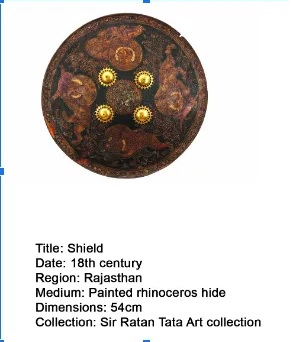 It is a shield used for exchange dowry made of rhinoceros hide from Rajasthan. It is an 18th-century royal object, and the diameter of the circular shield is 54cm. This artefact allows the Royal people to exchange wealth and dignity; Rajasthani wealthy people give the dowry, jewels, money and other items in this shield. This object locates in the Chhatrapati Shivaji Maharaj Vastu Sangrahalaya in Mumbai, India—this shield exchange dowry and expression of the royals for the wedding function.
It is a shield used for exchange dowry made of rhinoceros hide from Rajasthan. It is an 18th-century royal object, and the diameter of the circular shield is 54cm. This artefact allows the Royal people to exchange wealth and dignity; Rajasthani wealthy people give the dowry, jewels, money and other items in this shield. This object locates in the Chhatrapati Shivaji Maharaj Vastu Sangrahalaya in Mumbai, India—this shield exchange dowry and expression of the royals for the wedding function.
The artist painted the shield’s surface: four lions attacking blackbucks and bulls. The shield depicts plants and other tiny details of the different materials, and the guard carries knowledge about the social class and royal culture developed in the 18th century. The valuable aspect of the object is apparent.
Distance is clear from Tipu’s Tiger to the Rajasthani shield, but royals are the same everywhere, no doubt about that. We cannot calculate the real-time and space from these objects. Imagining the exchange ceremony of these objects takes work. Now we have this object only, taken from the royal tradition. Appadurai’s exchange theory works here perfectly. Exchanges make the value of things. Any hypothesise can work about the people who used this object to express the royals and as a social status symbol? The people who use and exchange this object exchange valuable things with other royal people. This exchange is happening between royal people. Just imagine the ceremony; this object became a mere object, not the central point.
The design and structure of the ceremony are highly royal. People come in a royal dresses, status and full of ornaments. They may have this kind of shield with gifts and presents for royal weddings. Many of them express their royalness to the public. Music, dance, food, and drinks are integral to these ceremonies.
The value is never an inherent property of objects, as Appadurai quoted Simmel in his text (1998). Value is a judgment made by a subject. Who is the issue here to judge and create value for this object? Value establishes the value of who uses this object and who receives this object with valuable gifts.
Every object has time and space; they are used, owned, and possessed as a royal. A royal wedding involves the expression of many royal things. The royal function creates valuable objects. The biographical element of the shield is closely related to the event, the wedding ceremony and the union of two royals. This shield is a meeting point for two royal families; they exchange royal gifts or valuable items with each other. We cannot deny the presence of royals in this object. This object is a part of royal design and architecture, and we cannot imagine this shield’s value and existence without architectural design.
Not everyone’s objects could be considered royal or ‘valuable’. Nevertheless, objects someone owns can be valuable to them in a personal manner since they are associated with their life. However, they are not worthwhile in what is considered valuable. Objects that connect with a low-profile life may not be regarded as valuable in the traditional sense.
If we imagine the function, the occasion of this object served as a royal gift, where the bride and groom of two royal families, family members, priests and musicians gather. Smells of rich food come across the window, the ceremonial hall filled with flowers and scents, and the elegant embellishment of various items. This shield\object is only a mere object of the wedding function. Even the bride and groom come for the wedding ceremony in a chariot. The city square is full of people gathered to watch the royal exhibition of the bride and groom. Everyone may throw flowers at the bride and groom.
Now we know the shield is a monumental icon for the Rajasthani royal wedding. The Decorative form of art represents the royal class and elite. This shield is rare for all Rajasthani weddings; it is a scarce object used by the royal group. Royal communities have a strong desire for royal things. The interaction of the royals is evident here. Every person and thing has a social life. People are recognised and accessed by the object they use. Objects are like a mirror of the people who use those objects. A reflected life and social order are there. We now know about the person who uses these or those objects.
According to Appadurai: ‘Commodities are an object outside us (1998). That object has some quality or properties that satisfy human wants of some sort or another. Here, the social need for valuable things meets people who want royal objects. Hierarchy and class division is there: poor\artist\craftsmanship and rich\royal\elite are connected in this object. Chris Gosden and Yvonne Marshall view the mutual connection to influential people and the fame of the things.
Pandan Box
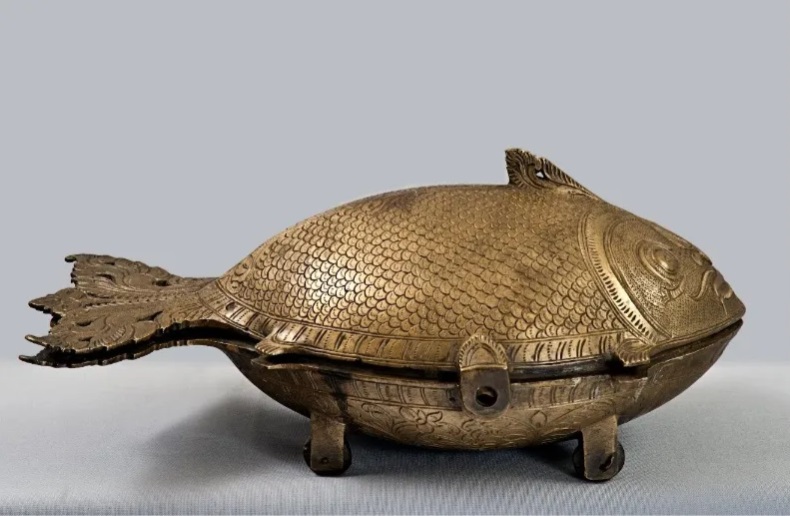
Credit: Google Art and Culture
A Pandan box is a fish-shaped storage box. The Created period is the 18th- 19th century, and the material is Brass. The Width of the box is 150cm, and the height of the box without its cover is 330cm. The use of these boxes is to store Pan or betel leaves and other items in the royal family. The box stands on four legs, and when it is closed, they look like fish. One can store the materials very safely inside the box and close it. There is a room for each item to store privately.
This object represents the social elite who use the Pan or betel to chew. They take the Pan or betel leaves from this box and use them publicly. This box is for private use when they are in public. That was the way richness became expressed to the public. The unidentified artist who created this box only knows who uses this one- engraved the details. Features of the fish are apparent in this work. This box is used in central India; now, we can see this object in the National Museum, New Delhi. The main point is that the metal craftsmanship of the Indian artist is evident and has flourished through the ages.
We just met the finest example of the finest craftsmanship. Indian metal artists created many animals, birds, fish and human-shaped utilitarian objects for wealthy people., we can see many things in our museums: the box perfectly designed to stand and the knob for opening.
The box decorates with a fish scale motif; the artists seemed fascinated to do these works. This box became a highly ornamented surface with an engraved shape and had five compartments inside for using various items separately. The pandan box also represents the Mythical’ Matsya’ avatar of Lord Vishnu.
So this box has some notional value and is essential for Hindu religious beliefs. Imagining the worth of this object from the perspective of religious, social, and cultural aspects and how a pandan box represents royalty and historical value reveals the association of human and object history. We only know a little more about these objects. Only the physical objects here. We appreciate the artistic style and material use of this object. The kind of exchange in these objects, how they became valuable, the ownership of the things, and other ways of value added to them remain unidentified.
This object has a stronger connection to people, time and space than we imagined. Objects give us the details of the stage settings, and stories played behind the stage. Objects are like the outer human body but integral to human life. The meaning of the objects is related to social action and life. Evidence and significance of the objects are associated with the persons and events to which it is connected.
The Pandan box is not a commodity in the sense of royal people purchasing from the market or sellers, and it would never be a gift. The artist created them and handed them to the royal people as gifts and commodities. At the same time, they keep the status of things and heritage because artisans get remuneration for their work. That was never a fundamental value of the work; they considered it a gift and gave them a bunch of gold or silver coins. Royals/Kingship gives the order to make the objects for their use, and if they are satisfied with the final product, they may give them some goods or gold as remuneration. That is why the absence of information regarding the object’s creator. According to Chris Gosden and Yvonne Marshall, ‘commodities are supposed to be alienable so that they can be transacted without leaving any lasting relationship between giver and receiver (1999),169–178).
Oil Lamp In the form of a bird
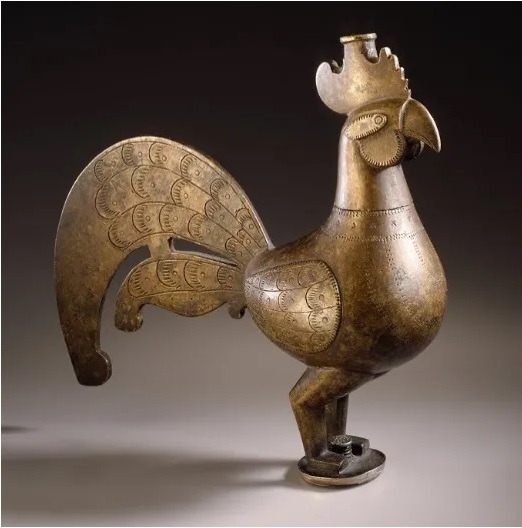
Credit: Google Art and Culture
An oil Lamp in the form of a bird was created in 17 century Deccan, India. Copper is the material for creating oil lamps. The diameter of the bird-shaped lamp is 15.88X 6.35X17.15cm. The lamp’s body contains oil, and the wick hole and the nozzle of the lamp are above the head of the bird used for the light. This object belongs to South Asian art.
The artist created this form for utilitarian desires, like many other objects for the royal people at this time. Animal and bird forms have been used to make useful objects for a long time. This bird lamp has four parts: the handle, stand, fuel chamber, wick hole, and nozzle. The primary function of the lamp is for lighting; this lamp may be a chamber light for the royal family and part of architecture- decorative form. The artist elaborately decorates this bird; the wings and tail of the bird are highly decorated like feathers. Head of the bird, neck, tail, legs, feathers: total design depicts the structure of a bird.
This object has the utilitarian value of a royal household item and may be used as a religious element to worship god. Hindu traditional use of fire rituals is connected to this object. Priestly commencement of prayer is related to fire in Hindu tradition. So this object may be used for that purpose. In Hindu tradition, lighting lamps for worship signifies the path of wisdom and divinity. Lights are not only for the darkness of the world but for life also. Without utilitarian values, no object has a solid life in the past.
Considering the object’s biography, what kind of history lies behind this oil lamp? Who uses this: priest for prayer or King for bedroom? Or at the dinner table or the reading-writing room light? This is a decorative object; no one can deny the presence of light in this object. This object is not only used for decorative items. All things have a history of desire and demand. The object should meet the desire and needs of the people. When passion and direction meet a point of interaction, there is the power to create economic value.
So, what communication is created in this oil lamp for us from the royal past? Who created this? There is no question like that. The only question raised from the beginning is about the object’s user. The creator is unknown, and the user is well known. That is the irony of all things we get from history. History stands with the user and not the creator.
We follow things for their meaning, use, and stories. What they tell us for the sake of royals and us from the point of unknown artistic identity. ‘Without human interactions, attributions and motivations, things have no meaning’ (Appadurai 1988:3). But that meaning is only related to who uses the things, not who creates them. Creators have no value; in other words, value is not connected to the creator. Value is the reflection or representation of the owner/user. The value of the object/things/artefacts is formed outside the creative sphere; like Simmel, one thinks ‘value is not inherent properties of the object, it is a judgement made by the subject’ (1998). Here the subject is ‘us’, and value is a judgment made in time and space.
Terracotta Krater and Aegis with the Head of Sekhmet
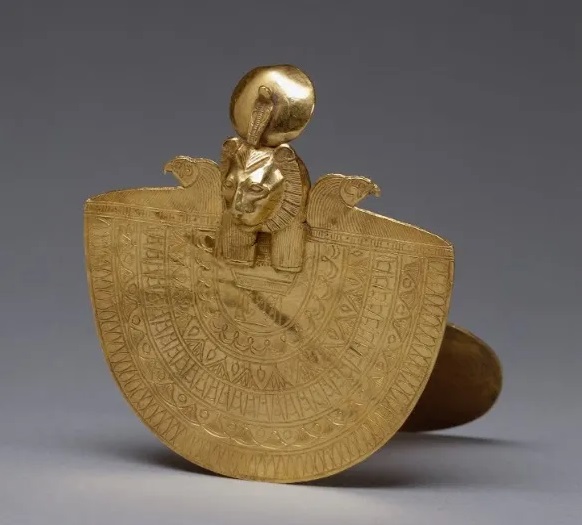
Credit: Google Art and Culture
These two objects are from ancient and different regions. Terracotta Krater is from Greek culture, and Aegis, the Head of Sekhmet, is from Egypt. The Terracotta Krater period is between 750–735 BC, and Aegis with the Head of Sekhmet is between 945–715 BCE. The relation between these two objects from different cultural spaces and times is that these two objects are connected to a significant human activity; a funeral ceremony.
Egyptian object is a collar-like necklace bearing the divine head of a feline goddess or lioness. This symbol is considered a symbol of protection and fertility cult. This golden object is a piece of jewellery of the royal family used for funeral activities in the 22nd-23rd dynasty. The physical dimension of the object is 6.8 x 6.6 x 6.8 cm. Terracotta Krater is a vase or Krater made of Terracotta. The height of the Krater is 108.3cm, the diameter is 72.4cm, and artists painted narratives, geometric designs and motifs on the surface of the Krater. This object represented the narratives of the funeral and was used for monumental grave markers.
Aegis, with the Head of Sekhmet, was acquired by Henry Walters in 1924 from Egypt and is now located in The Walters Art Museum in Baltimore, USA. No doubt about the aristocratic element of these objects, but the utilitarian value is apparent here. Ancient Egyptian royals used many things like this to communicate with their royals. We meet an object from the southern part of India, Tipu’s Tiger, that shows how the Kings depict or preserve the Kingship. This collar neckwear shows clear evidence of how the King or the royal family members expressed loyalty in Ancient Egypt.
Terracotta Krater is from the Greek culture and was created by the Greek stone sculptures to use Archaic funeral ceremonies. Krater is represented by and for the funeral ceremony; narratives depict the funeral events. In Krater, a story narrates the dead person surrounded by family members; all mourn and stay together with the dead. This object has some ritualistic elements and may be created for the ceremonial funeral practice. Funeral mourning is an essential ritual for the ancient people. The narratives provide clear evidence of who is dead; the dead person is a part of the royal family — some military references to an aristocratic family and royals in the Krater.
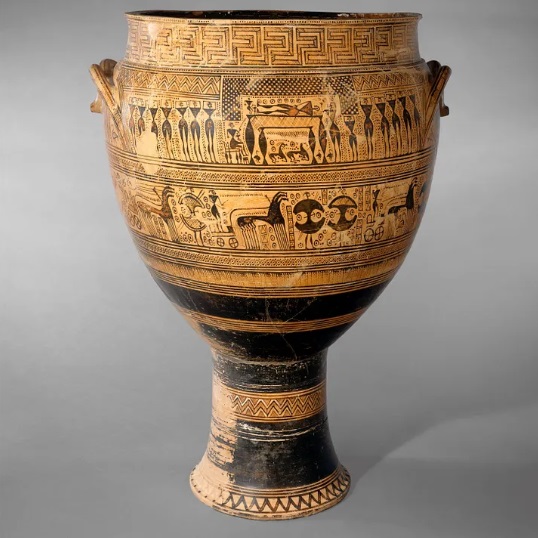
Credit: Google Art and Culture
These two objects from Greece and Egypt give us a clear picture of how aristocratic people made their objects. Their royals lay behind the screen of what we saw on the surface of their life. The motif and narration depict the story and the life of the royal people of different ages and landscapes.
Conclusion
A brief conclusion drawn from the six objects from different parts of the world and periods is that things and life in the past belonged to the royal people. We did not get the objects from the poor people. That does not mean that poor people do not use things.
However, we may take the objects from the royal people when history depicts the people and things. Appadurai gives some ideas about the commodity perspective made by Marx that ‘commodity is a product intended principally for exchange’ (Appadurai 1988: 4). But how can this perspective be made the way of these objects and their meaning?
These objects have a commodity perspective; they are exchanged from one person to another. The First-person may be an artist who creates these objects. The second person may be the owner or user of these objects. We are curious to know if any intermediator exists, bringing out the possibility of a multi-layer exchange. The owner creates and maintains the value of the things, depending on an aristocratic family or King. However, there were still some doubts about the exchange value theory because the King ordered them to create something, and an artist or craftsman made them address the royal need. Looking at the objects from various spaces reveals something like the order to obey patterns. Tipu Sultan has a solid connection to the Tiger motif, and the Ancient Egyptian aristocratic family or King have a link to the Lion motif. Both objects reveal the royal need and extreme craftsmanship to fulfil the royal need. These objects’ value depends not on the exchange but on the owner or who possessed them.
Material forms exist in every society in different formats like ‘products’, ‘objects’, ‘goods’, and ‘artefacts’. The above objects are placed in various forms. They are free from the prejudice of social conditioning. However, they are not free of the hypothesis related to the ignorance of artists, and they never move freely in the world of power and hierarchy. Kingship or royal patronage creates the value of these objects. That value hides the power and hierarchy played in these objects.
Regarding Arjun Appadurai’s argument on the objects, the ‘existence of commodities, at least in a primitive form’ (Appaduari 1988:5) is valid and essential. Our objects are not in the modern sense but some primitive objects. Object life existed before money became a determined value. The production of the objects played a key role here.
These objects are created for the royal people or the King. Barter may not be the exchange form; artists may get the exchange value in gold or silver. That does not mean royal people treat these objects as valuable. They may use and symbolically address the royalness of these objects. However, they use these objects in the form of daily life objects. Ritualistic value is another form of value formed in objects and rituals.
The perspective of commodity and gift comes from capitalist society. However, both views have a problem dealing with primitive society or before the capitalist social structure. The commodity or gift objects in this list keep the position between these two perspectives. They are not commodities and gifts. They are ‘artefacts’ or ‘things’ with a solid social background of power and hierarchy dealing with the matter. However, they might need more power to argue about the value of the objects created by them.
King or royal people may give the things or objects as gifts to another king or royal people. How can we take it as a gift? Because artists are never treated well, the objects are treated well and considered a mode of transaction. The above things may be received as a gift from the other people of an aristocratic family. We do not know the source of the object. We consider the object valuable, not because of the production source but of who owns and uses the thing. When the objects produce, they are treated as worthwhile because the creator knows very well about the user or who has become the owner. Who became possessed, and where these objects have life and are treated as ordinary objects. However, that person and place are valuable, or that person and place claim that. Then, value is a claim- not only the judgement- done by the subject and the space. Think with things is a reading method of the objects and artefacts. Objects convey what people think and how to understand the time and space of the entities.
Then, Appadurai suggests a ‘commodity situation’ about the exchangeability between the objects’ past, present and future. It is about a socially relevant lot of things. Commodity phase, commodity candidacy and commodity context are three definitions given by Appadurai. The above objects and these observations connect on many points; they use in different situations, significantly different occasions, conditions and events. If we think about the design, structure and materials, these objects are more than valuable: the most refined product of the craftsmanship of the time. The situation changes when considering the objects’ power, hierarchy, and distribution. What is the objects’ exchange value or social life from the premodern period? Some things are from the ancient worlds, some from the premodern, and some from the colonial era.
The whole meaning of the objects is never possible. We need to approach different viewpoints and perspectives. Some give or guide us to ancient people’s world, customs, and culture. We get insights into religious practice and how other traditions developed and evolved. Some objects give us a clue about how Kingship experienced their life and how luxurious they were. Their lamp, pandan box and all things elegantly designed and royally decorated; these patterns of royals can be seen in many places in many forms. The popular culture of royals follows these design and style patterns in the contemporary world. Now, after this ‘object’ reading, how things and styles travel from time to time and space to space can be understood. Surprisingly, some objects keep their meaning and status in different situations and spaces, even if they are replicas or mechanical reproductions. The definition of status is fixed in objects, and then they keep the status even if the piece of object is copied. That is the understanding for now about the objects.
Some objects are made as copies, replicas or mechanical reproductions; Tipu’s Tiger has no representation or copy. We have only one Tipu Tiger. Shield, Terracotta Krater, and Aegis with the Head of Sekhmet: possibility is that many original objects are there. There are many royal families in Rajasthan. So there is the possibility of the existence of many wedding shields. Terracotta Kraters are funeral objects, and there are many royal deaths, so Kraters. The story of the Aegis may be the same. The story turns into culture and tradition when we take the Pandan box and oil lamp. We may see these objects in our life in different forms and storyboards. There are royal people and many rooms, so there is the possibility of many oil lamps and pandan boxes in their original condition.
There is the possibility of another style of journey. Some objects continue the royal journey to the famous contemporary world as symbols and techniques. Their utility may change, and their social life is different now. Betel leaf boxes are here in various materials and forms. The social life of things and their conditions travel from time to time and space to space in different ways and causes. Their storyboard is different, visible as a separate object and form. However, realise these objects have made a long journey before when they encounter us in another state. Some things share a seat with culture and tradition on the long road of human evolution.
The utilitarian value of the objects and use may happen differently now. Rajasthani wedding shields are not used the same way now, and Tipu’s Tiger is unique. Terracotta Krater’s pattern, form and small design may be used for valuable objects and fashions. It has already mentioned the possibilities and presence of the Pandan box and Oil lamp in the contemporary world. Things are here and there in many meanings and forms in our world. Our recent experience of objects is ancient, too, in a sense. They travel from the ancient world to the contemporary world of object experience.
‘In principle, the work of art has always been reproducible. What man has made, man has always been able to drive again. Such copying was also done by pupils as an artistic exercise, by masters to give works wider circulation, and ultimately by anyone seeking to make money (Benjamin 1935: 1). Benjamin makes a clear argument from the more expansive viewpoint, which here trying to prove. This reproduction helped spread the royal and aristocratic design patterns and styles to the contemporary world. They are here in recent experience to demonstrate the human capacity of reproduction and carry it over from generation to generation and from time to time. Our ancient peoples’ designs and patterns are still in use in our designed world. In other words, those objects create the contemporary experience as designed. We live in a world designed by objects.
Please pay attention to the craftsmanship and their engagement with different materials. That engagement makes the possibility of these objects. Object history tells the material history too. Wood, clay, gold and many other materials are there. Artists meet the social need and patronage: the everlasting story tells us the material and social history of the objects. Then, objects tell the story of the world’s material, social, hierarchical, and artistic history from different viewpoints. ‘We have objects that reveal our travels as souvenirs (Hurcombe: 2006:1). These objects are archaeological artefacts and considered reading material culture. These objects are souvenirs, too; they get them from festivals and gatherings from the distant past. Now we consider these objects mementoes of their life, custom, tradition and belief.
We experienced life in the sphere of material culture. We touch, wear and own the material\object; that is how our lived experience explores the world of materiality. ‘Materialism and humanism are thus natural bedfellows (Eagleton: 2016: 1). Maybe now we are convinced by the scholar’s insightful comments on material culture. That is true, and there is no difference between the life of materials and humans.
Bibliography
1. Appadurai, Arjun. The Social Life of Things. USA: Cambridge University Press, 1986.
2. Fabian, Johannes. “On Recognising Things. The “Ethnic Artefact” and the “Ethnographic Object”.” L’Homme, no. 170 (2004): 47–60.
3. Gosde, Chris and Marshall, Yvonne. ‘’The Cultural Biography of Objects’’ World Archaeology, Vol. 31, №2, 169–178. Taylor & Francis Ltd, 1999.
4. Fabian, Johannes. Time and the Other: how anthropology makes its Object. New York: Columbia University Press, 2014.
5. Benjamin, Walter. The Work of Art in the Age of Mechanical Reproduction. England: Penguin Books, 2008.
6. Hurcombe, Linda M. Archaeological Artefacts as Material Culture. New York: Routledge, 2009.
7. Eagleton, Terry. Materialism. America: Yale University, 2016.

